MERCEDES-BENZ 300 SL


8 Content 14 History MERCEDES TAKES FLIGHT 40 Design FORM FOLLOWS FUNCTION 50 Culture A STAR FOR THE STARS 86 History of the Model A PERFECT BLEND FOR THE SENSES 96 Innovation ADVANCEMENT THROUGH IDEAS 106 Details
PRECIOUS LITTLE THINGS
9 116 Motor Sports THE TRIUMPH OF SPEED 138 Successors THE SL LEGACY 159/160 Photo Credits/Imprint 154 Making-of THE LIGHT PLAY OF RENÉ STAUD 158 Time Travel MERCEDES-BENZ 300 SL LIVE & ON SITE
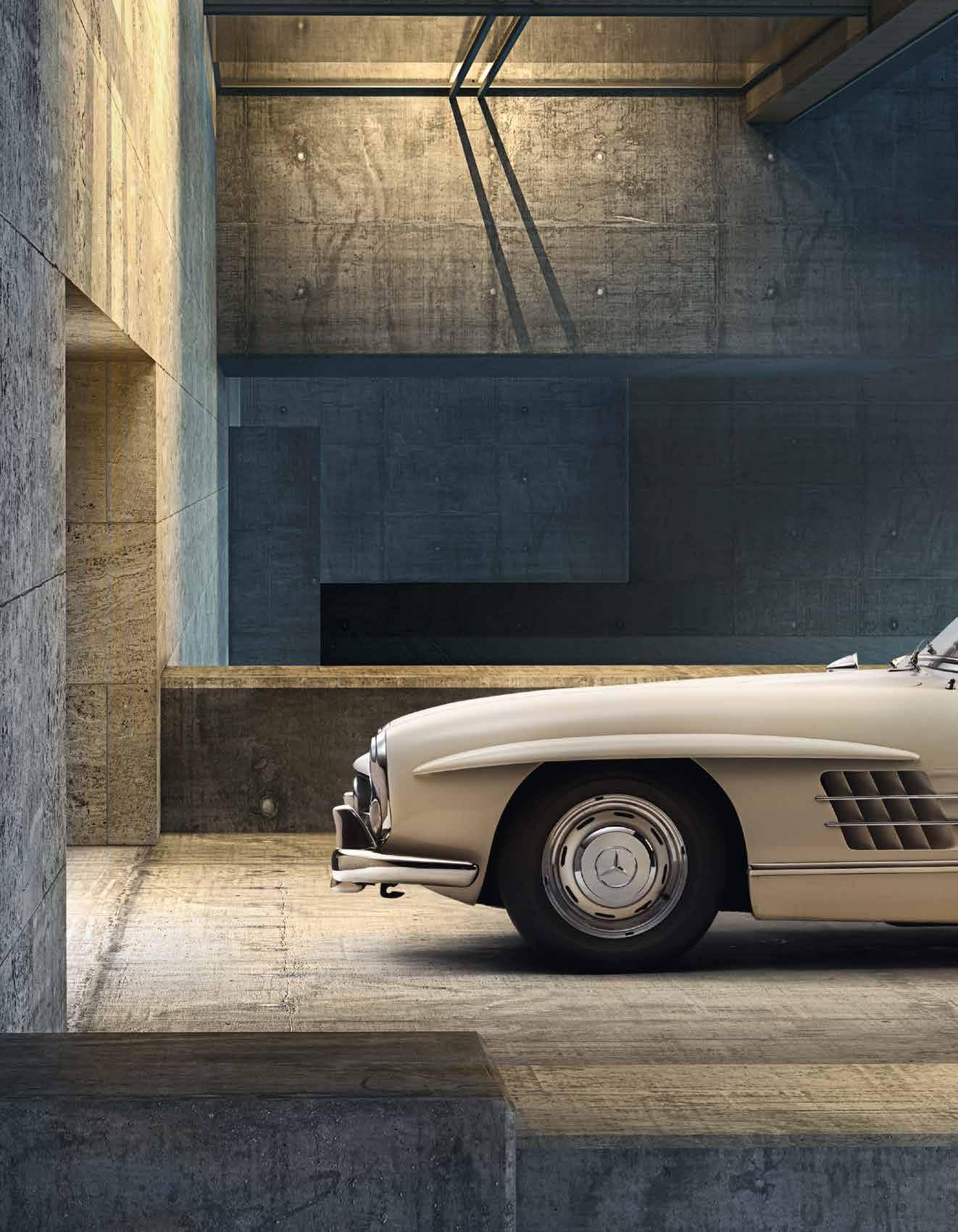
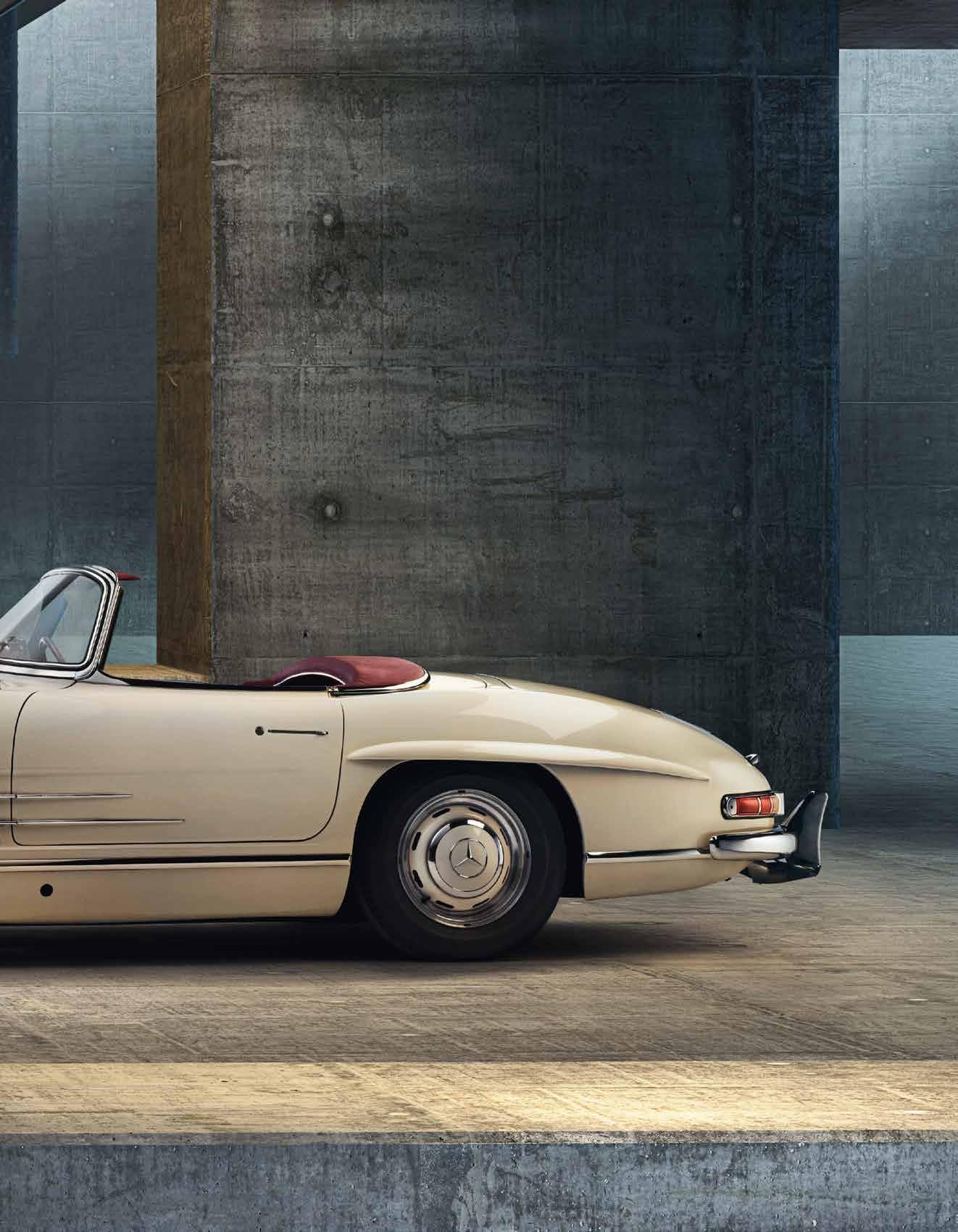
MYTH-MAKING: PART I & II
What followed was a prime example of creative problem solving, or in other words, myth-making part I. Despite, or in part even because of, the limitations of the time, such as existing regulations and technical requirements, the 300 SL was an automobile that would become an absolute legend. Details are described in the “Design” and “Innovation” chapters. But, in
brief: The in-line six-cylinder engine was modified to increase its power. The chassis was designed to be as good—and, importantly, as light-weight—as possible, using all the tricks they could muster. The tubular frame introduced by Rudolf Uhlenhaut and dramatic gull-wing doors not only delivered the desired improvements, but also ensured that, in compari-
1955 1957
Bittersweet triumph: Despite the Le Mans tragedy, the 300 SLR still wins a world championship. Stirling Moss earns this distinction at the Targa Florio on October 16.
Finale for the Gullwing: The production of the 300 SL coupé with the dramatic gull-wing doors is discontinued in order to make space for the roadster.
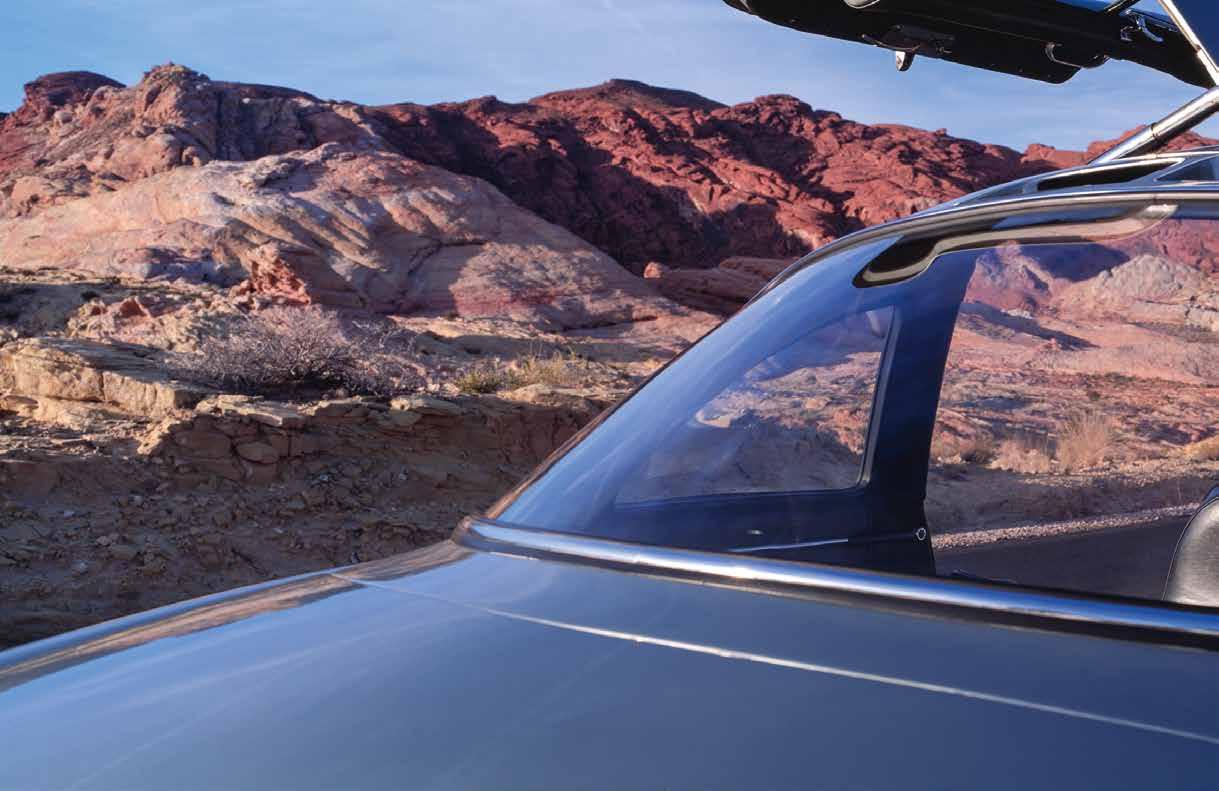
1957
Long live the 300 SL roadster: The roadster, which is designed to satisfy US buyers’ desire for more comfort, celebrates its premiere at the Geneva Motor Show in March.
24
In the US, the car with the “Flügeltüren” is christened the Gullwing. Importer Max Hoffman increased sales figures for all Mercedes models from 253 to 6048 in the years from 1952 until 1957.
son to proper race cars, the 300 SL would become an unusually refined vehicle.

It is not surprising that the racing sports car attracted attention when it appeared on the starting line in early 1952—for Mercedes, the first time in this category since the war. Although Alfred Neubauer tried to integrate more power, lower weight,
and larger tires in the car up to the very end (“The press and public in Germany expect an overall win from a Mercedes sports car in my hands”), he came to terms with the car. He would rather compete with this vehicle than not compete at all. Thus, the path was clear for a racing success story, or mythmaking part II. Many small parts work together to ensure an
1961
Fans of
1963
The end of an era: After 1858 units built, production of the Mercedes 300 SL roadster is discontinued.
1963–1971
Successor 1: As a direct descendant, the 230 SL (starting in 1967/68: 250 SL and 280 SL) appears on the scene. Due to the shape of its roof, it is nicknamed the “Pagoda.”
25
the Gullwing: The Gull Wing Group International is founded in San Francisco. Number of founding members: 18.
History—Mercedes Takes Flight
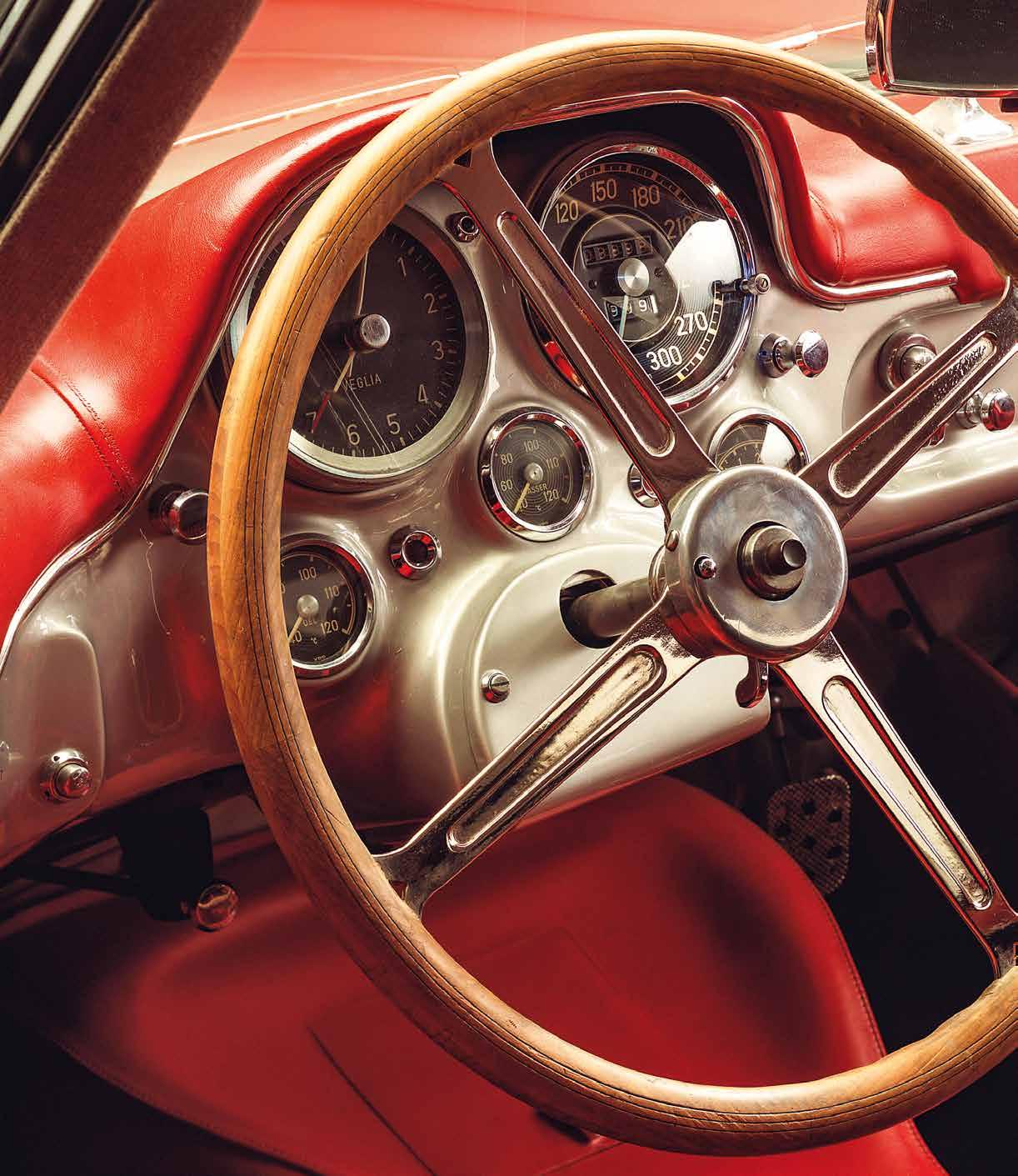
26
The first 300 SLs were delivered with two-spoke steering wheels—from today’s point of view, a safety risk in case of frontal collisions. The car known as the Uhlenhaut Coupé from 1955 already had a steering wheel with four spokes.
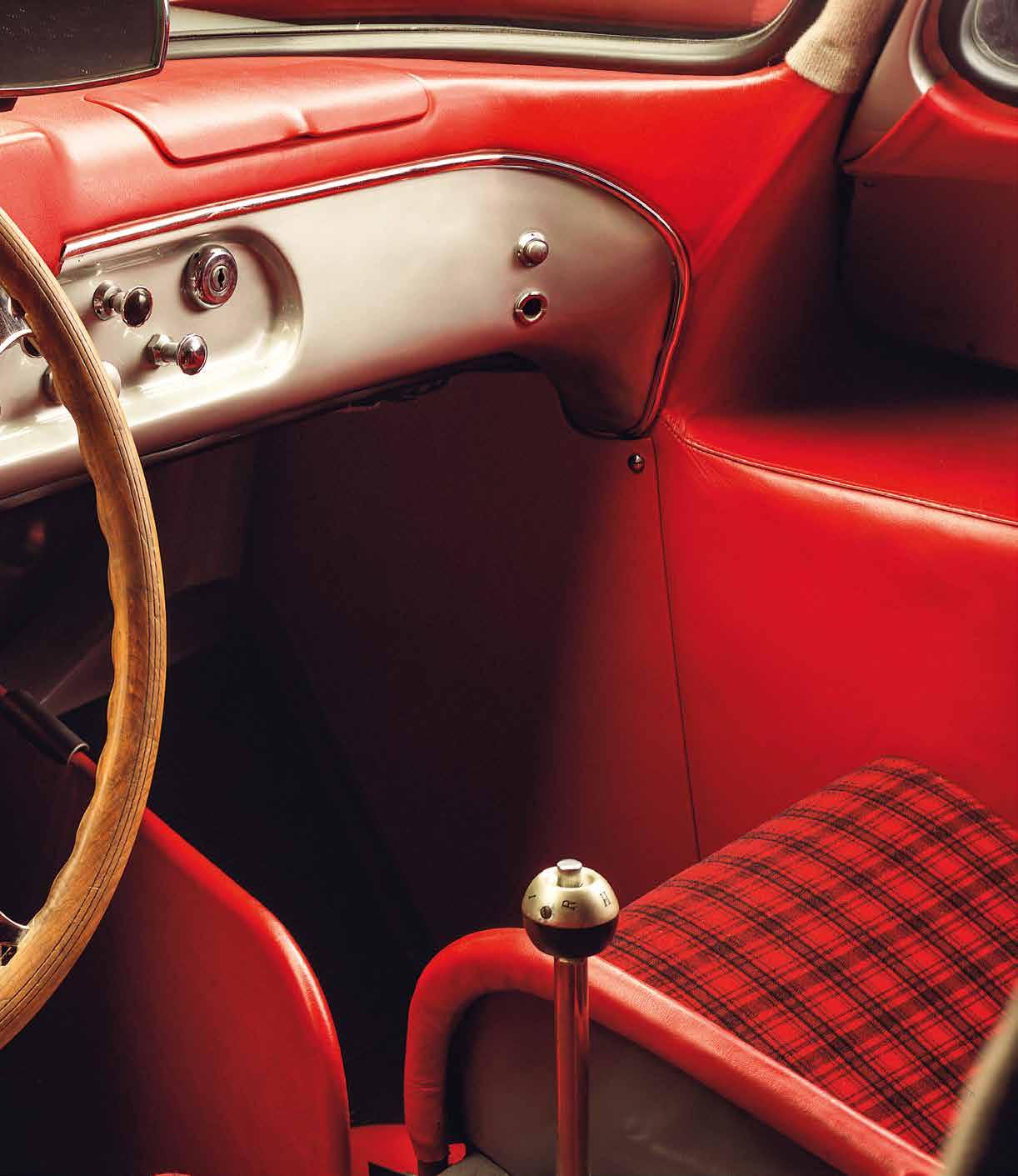
27
A critical point in the development of the 300 SL was the double-win at the Carrera Panamericana in November 1952. A vehicle with the characteristics of the 1953 prototype would have surely won on the racetrack, but the car suddenly had a new purpose. After the victory at the Carrera Panamericana, the US market discovered vehicles from Daimler-Benz. Importer Max Hoffman suggested the Stuttgart automaker build a road vehicle from the successful race car for his rich clientèle. For this transformation, an injection engine was integrated, while the significantly improved chassis was omitted on instructions from the accountants they had back then, too—a confounding choice to this very day. On the other hand, they had agreed on a sales price of 29,000 German marks and wanted to steer clear of the territory of the 34,500 German mark 300 Sc coupé. Despite this, the development of the 300 SL was a triumph.
BIG IN AMERICA
Preparations for the presentation of the series-production 300 SL began in the spring of 1953. It celebrated its world premiere at the International Motor Sports Show in New York, which took place from February 6 to 14, 1954. For the first time,
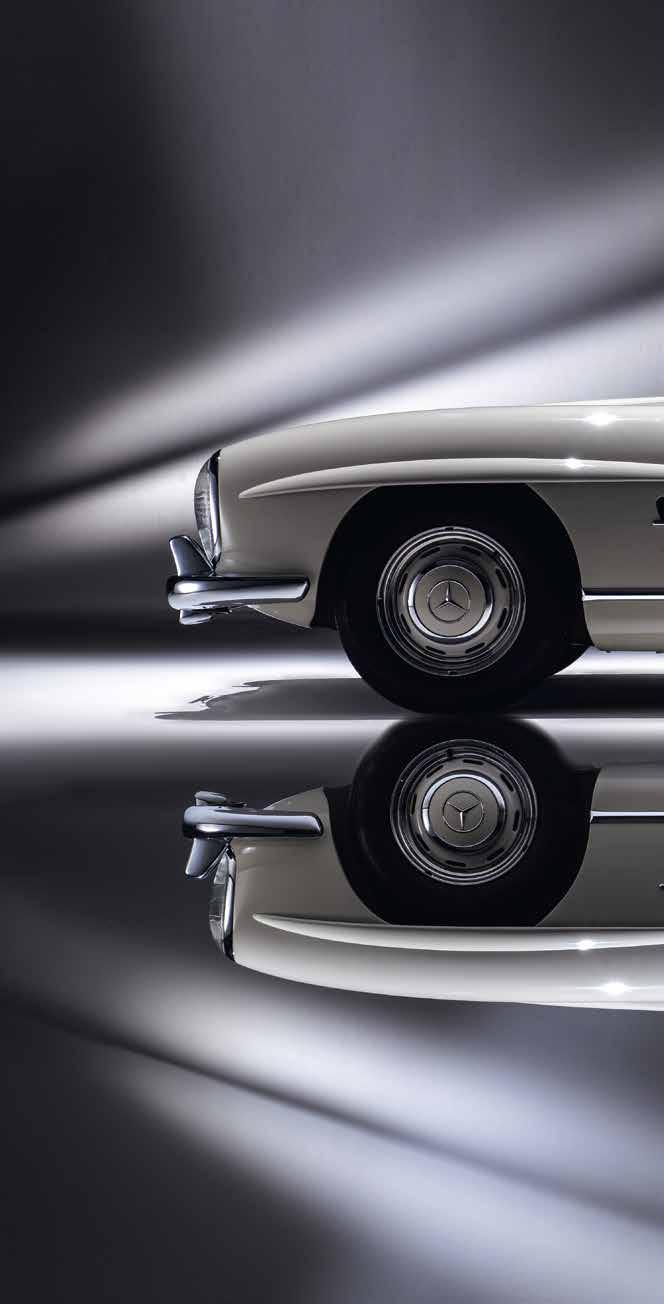
30
Starting in 1957, those who preferred a powerful roadster over an incognito race car could choose the 300 SL roadster.
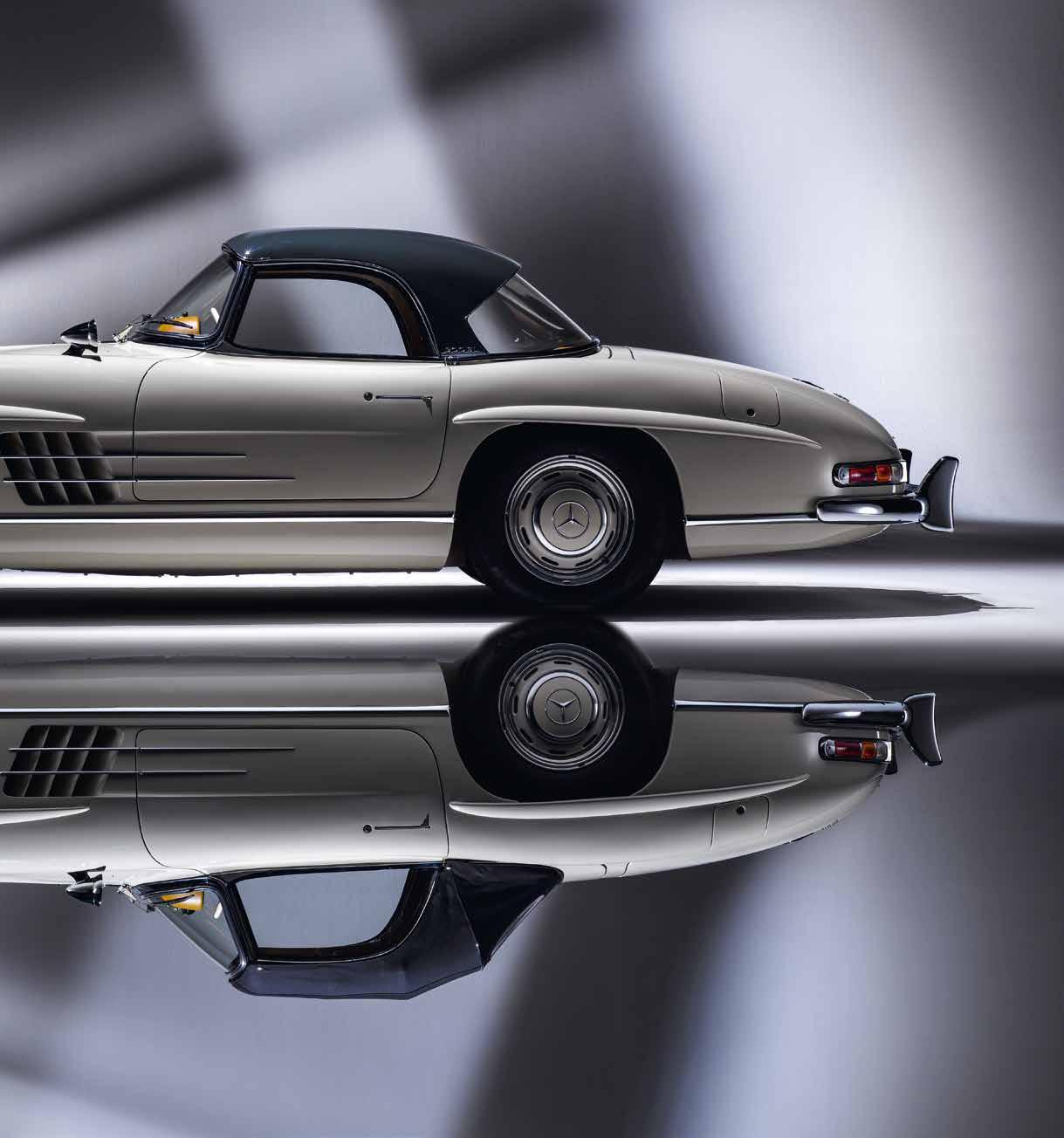
31 History—Mercedes Takes Flight

70
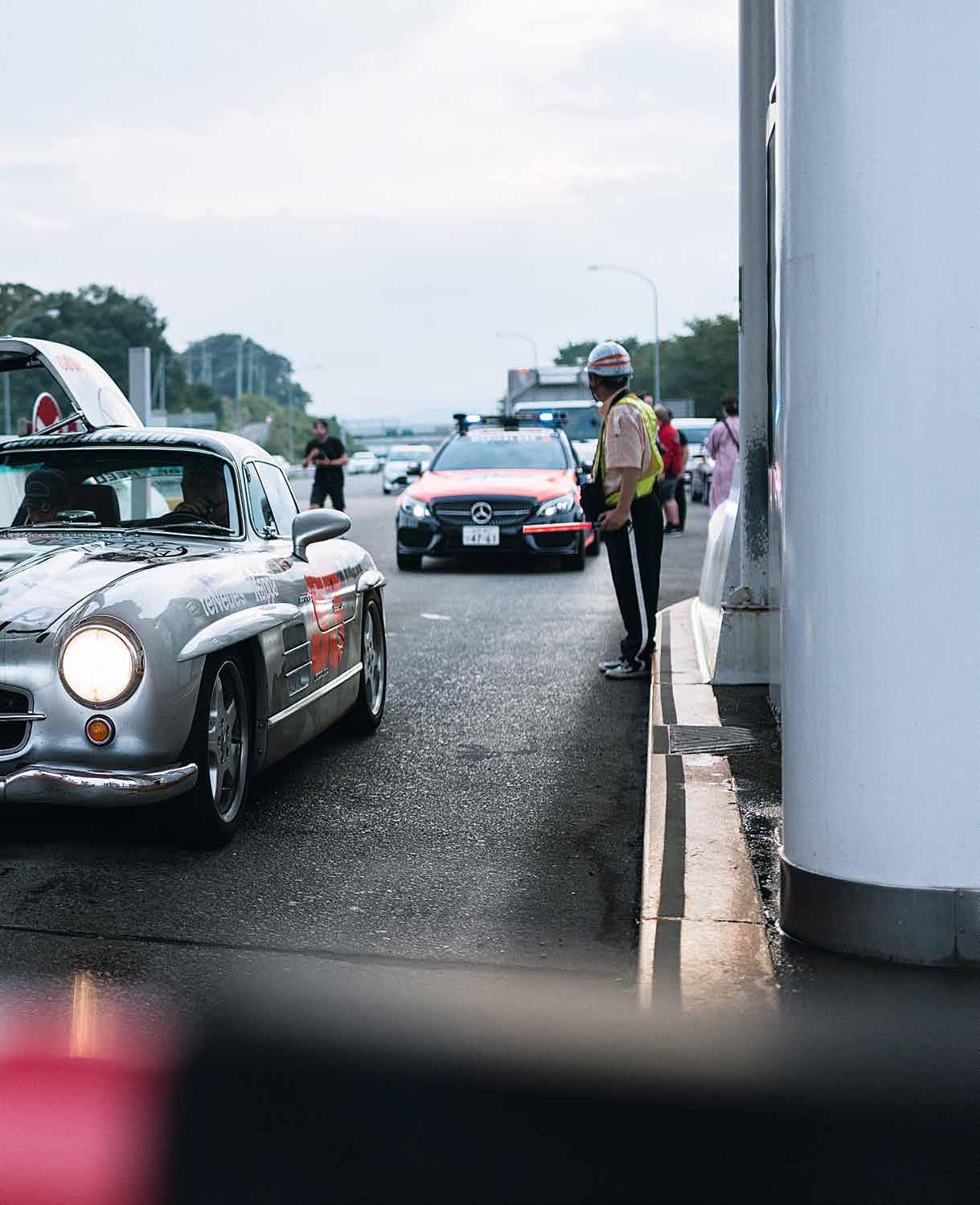
71
In Japan, passengers have to pay the toll—right-hand drive vehicles were never built. The photograph comes from the Gumball 3000, one of the most exciting automotive events of our times. The 2018 tour took participants from London to Tokyo.
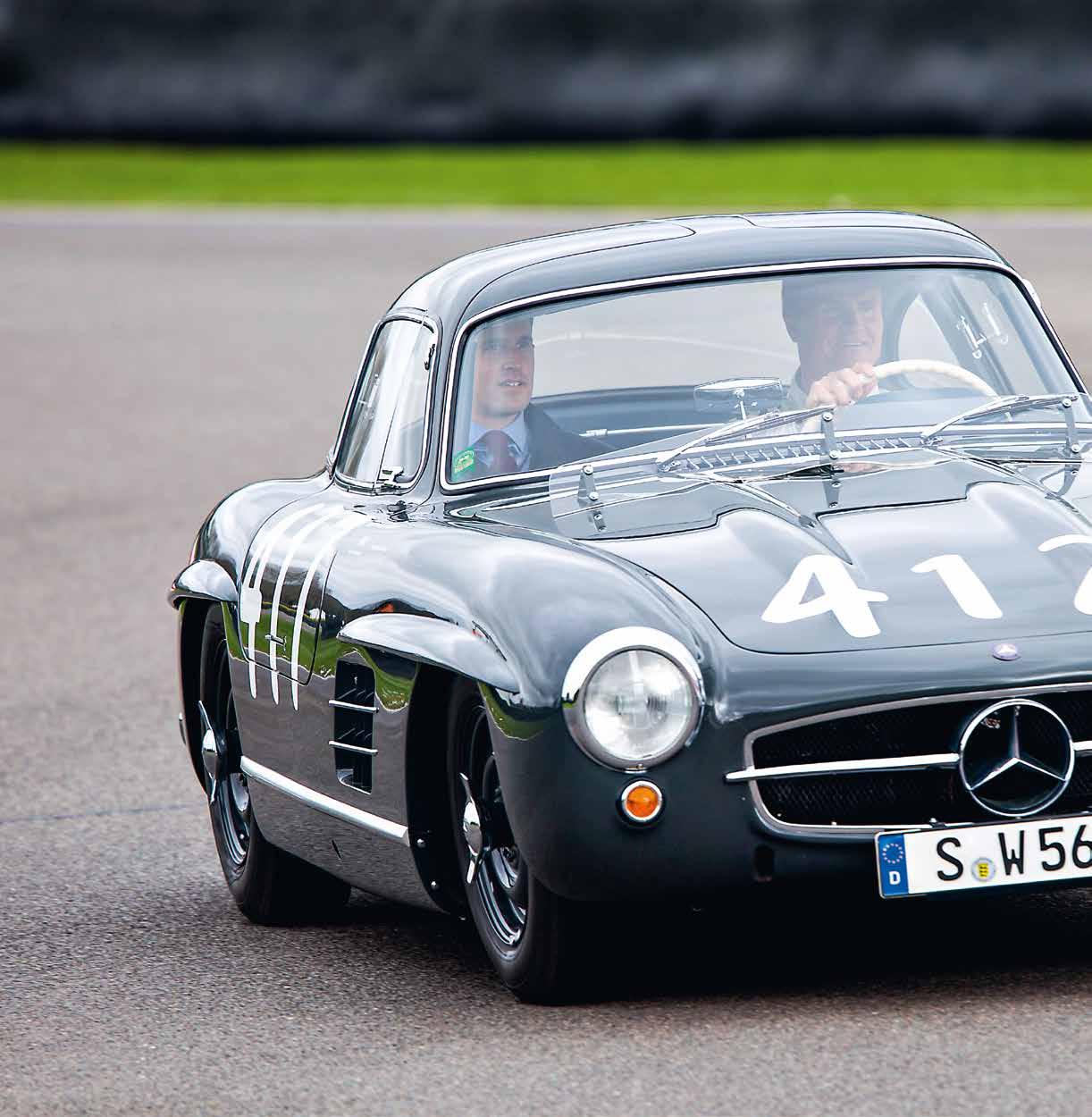
74
With the start number 417, John Fitch and Kurt Gesell took the class win and placed 5th in the overall ranking at the Mille Miglia in 1955—and in 2017, on the occasion of the 75th Member’s Meeting, the classic car started in the legendary race on the Goodwood Circuit in the South of England.

75
Star
the Stars
Culture A
for
Next to the Targa Florio, the Mille Miglia was considered the most difficult endurance race for sports cars up to the end of 1957. Since 1977, a tour with historic vehicles has been organized under this name—and a 300 SL is guaranteed to be present each year.

76

77
mitment, which would result in winning world championship titles in 1954 and 1955. At the same time, the engineers discovered that the 2.5-liter in-line eightcylinder engine could also be used in the races for the World Sportscar Championship by enlarging the displacement to three liters. This lead to the development of the 300 SLR sports car, which seized its second world championship in 1955— concurrent to the second win of the Formula 1 title. The Uhlenhaut Coupé even more famous, however. Only two units were ever built of the 300 SLR coupé, which featured a racing engine and a top speed over 174 mph (280 km/h), and which the head engineer drove in daily traffic.
WORTHY SUCCESSOR: THE ROADSTER
The 300 SL roadster was presented at the Geneva Motor Show in March 1957. As with the coupé, importer Max Hoffman also provided key motivation for the development of the roadster. He had known that there was desire for a degree of comfort, especially on the American

94
History of the Model A Perfect Blend for the Senses
300 SL ROADSTER (W 198 II)

Production years: 1957–1963
Engine: In-line six-cylinder engine with direct injection
Displacement: 2996 cm³
Output: 158 kW (215 metric HP) at 5800 rpm
Acceleration 0-62 mph (0–100 km/h): 10 s
Top speed: 155 mph (250 km/h)
Weight: 3131 lbs. (1420 kg)
Dimensions (L x W x H): 180 x 70 x 51 in (4570 x 1790 x 1300 mm)
Quantity: 1858
market, which the coupé lacked. Production of the roadster began in 1957, and that of the coupé was discontinued in the same year.
Of course, a tubular frame also provided the necessary torsional strength in the roadster, but it now had “normal” doors and the single-joint swing axle, which had been featured on the prototype from 1953, in order to improve driving dynamics. With a top speed of 155 mph (250 km/h), the 300 SL roadster was also among the fastest vehicles on the roads, doing justice to its heritage as the successor of the race car from 1952.
95
The SL of the R 107 series was launched in 1971 and held on until 1989. The responsible designer: Friedrich Geiger, who had previously developed the original 300 SL.
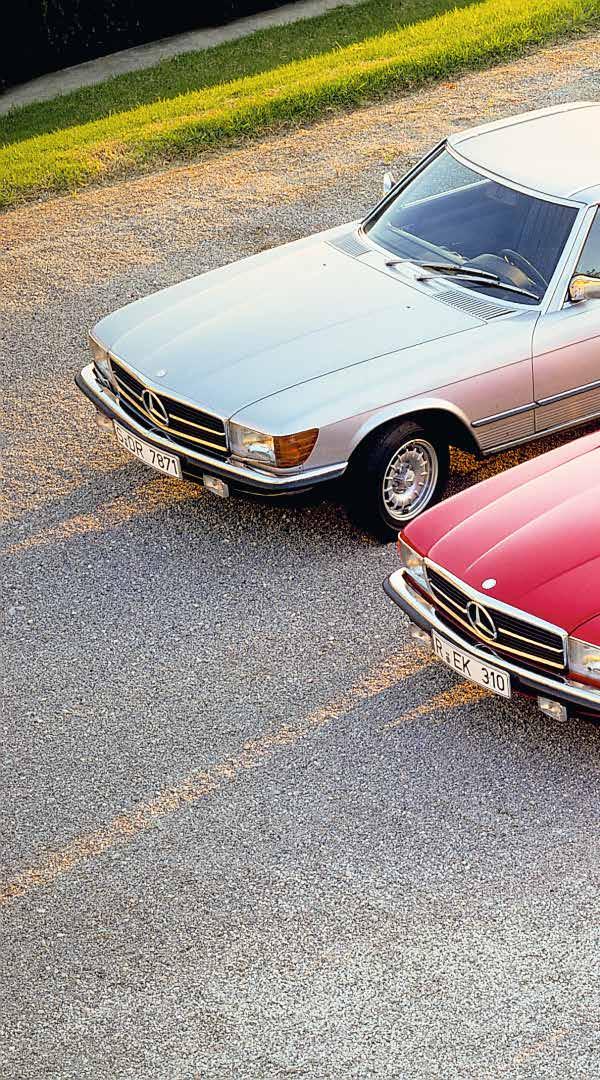
scene. Its members now wore the star in the center of the radiator grill.
The 190 SL was powered by a 1.9-liter four-cylinder engine with 105 metric HP, giving it a top speed of 106 mph (171 km/h). This made it one of the fastest touring sports cars of its time. Meanwhile, the Swiss magazine Automobil Revue had this to say in November 1956: “Despite its high performance, the 190 SL is not a real sports car. Instead, it is a straightforward, serious touring car with all four of its tires firmly on the ground, so to speak. Thanks to its exemplary driving characteristics, it is one of the few vehicle types with which you can reach maximum average speeds in complete safety, without rushing, and with full consideration to other cars on the road.”
With respect to legend status, the 190 SL definitely cannot keep up with the 300 SL. However, the first open-top series-production sports car of the SL family became a real sales success. Between 1955 and 1963, 25,881 units of the 190 SL were built.
144
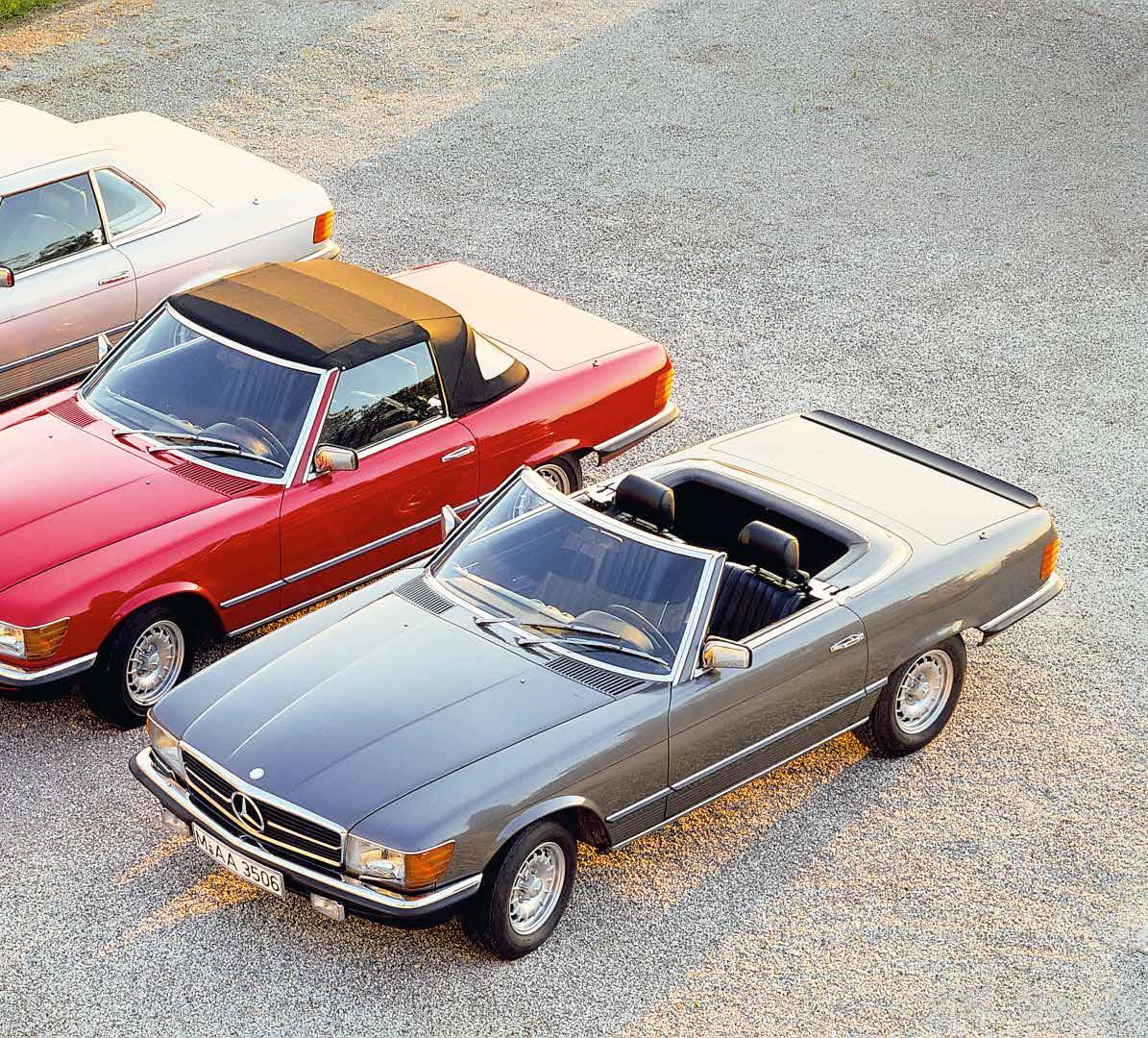
145 Successors The SL Legacy
The SL class is continued by the R 230 in 2001. The convertible offers a folding hardtop made of aluminum which can be stowed in the trunk using an electrohydraulic system.

and typical fluted side panels. As a whole, it had a much edgier appearance than its predecessors. This did not diminish its popularity: in total, 237,287 units were produced.
TAKING DESCENDANTS INTO NEW TERRITORY
The success story was continued by the descendents of the 300 SL. For example, take the R 129, built between 1989 and 2001 with a total of 204,940 units. A twelve-cylinder engine was used for the first time here, and the first official AMG versions of it were produced, i.e. high-performance vehicles developed by Mercedes subsidiary AMG Or the R 230 (2001–2012), also equipped with the latest technology, which won over 169,434 buyers. Or the SLR McLaren (2003–2009), of which 2,100 units were built.
148
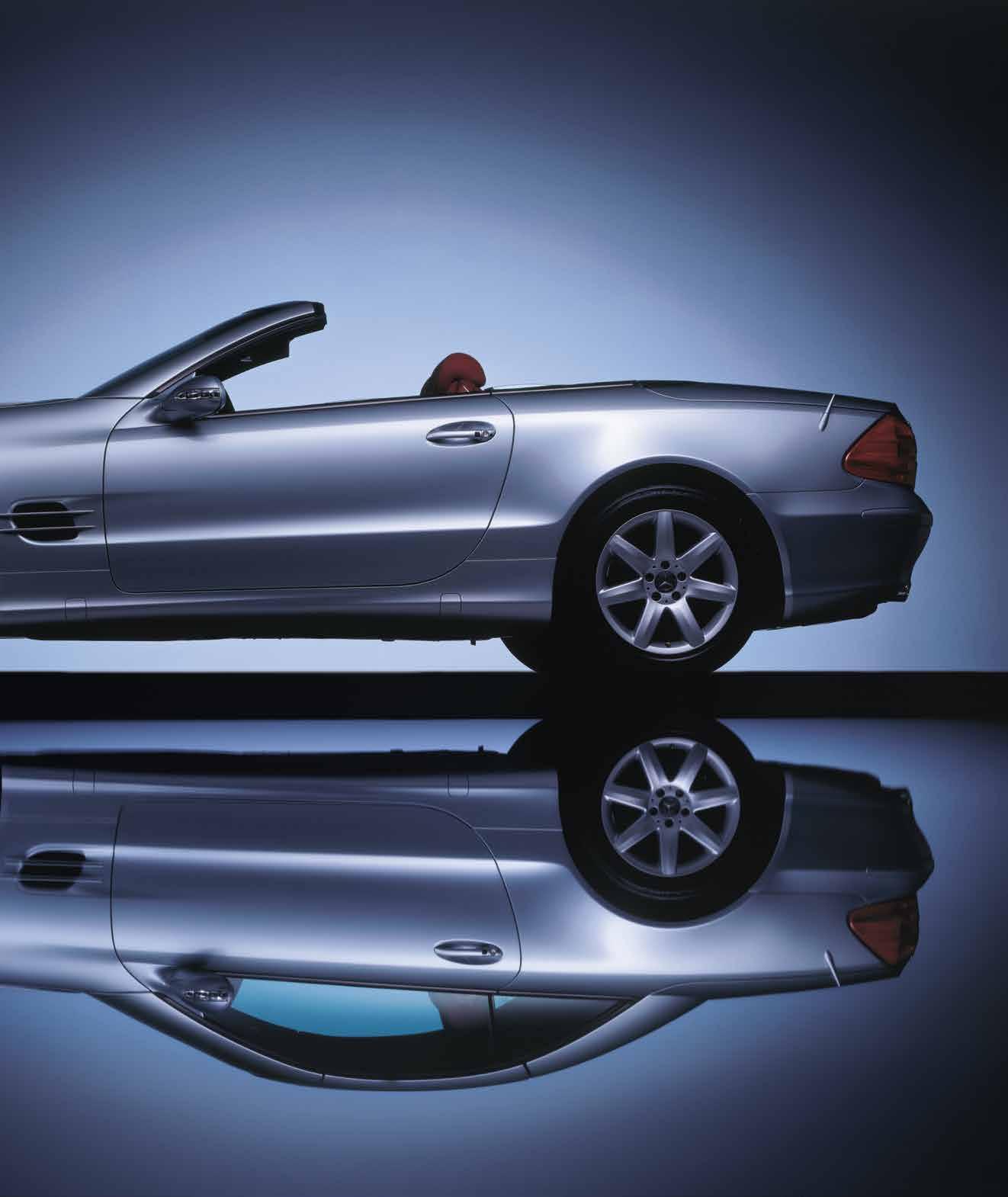
149
It was called “Gullwing” in the US, where it saw its greatest popularity. For a car like the Mercedes-Benz 300 SL, there is no more elegant, perfectly apt name. The word encompasses the ease, elegance, and poetry that radiates from this sports car.
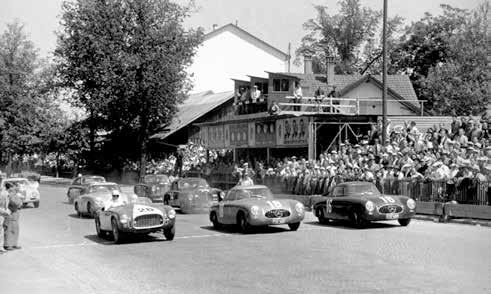
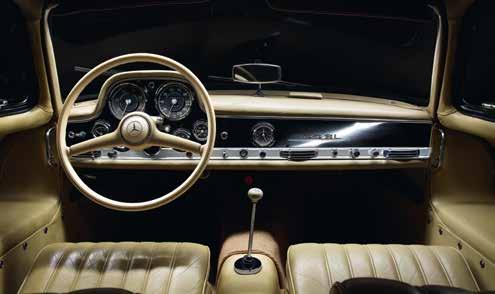
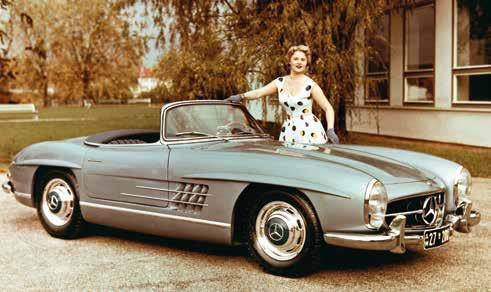
IconiCars Mercedes-Benz 300 SL offers everything you expect, plus a fresh look at the subject: wonderfully aesthetic automobile photography by René Staud and archive images with a beautiful sheen; shots of racing victories at the 24 Hours of Le Mans or the Carrera Panamericana; information about the model history and trailblazing technology; interesting facts about the iconic design and film appearances of the “sports car of the century.” This kaleidoscope of information and images soars above the usual automotive literature. ISBN 978-3-96171-413-1
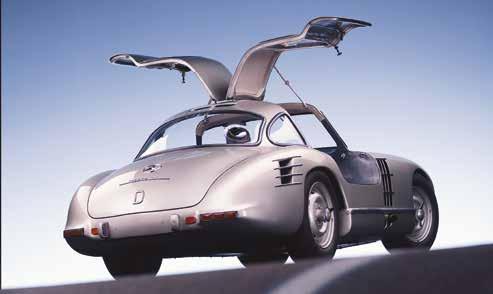
Printed in Slovakia 9 783961 714131 www.teneues.com


























